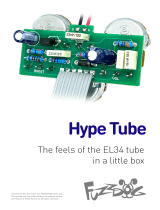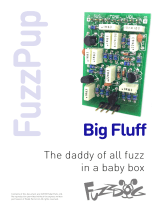Page is loading ...

Lester Fuzz
Ramesses’ less
tweaky brother
Contents of this document are ©2018 Pedal Parts Ltd.
No reproduction permitted without the express written
permission of Pedal Parts Ltd. All rights reserved.

Schematic
R1 39K
R2 100K
R3 470K
R4 100R
R5 15K
R6 empty
R7 1K
R8 15K
R9 100K
R10 470K
R11 15K
R12 100R
R13 15K
R14 100R
R15 470K
R16 100K
R17 15K
R18 470K
R19 CLR (2K2)
R21 100K
R22 470K
R23 1K2
R24 15K
R25 2M
C1 100n*
C2 560p
C3 100n
C4 100n
C5 560p
C6 100n
C7 100n
C8 560p
C9 100n
C10 1n
C11 10n
C12 100n
C13 100n
C14 100u elec
Q1-4 MPSA12
D1-2 1N4148
D3-4 1N4001
D5-7 empty
SHIFT 50KB
SUST 100KA
TONE 250KB
VOL 100KA
HI-LO
Jumper**
DIODE
Jumper**
*It’s preferable to use a 2.5mm pitch cap for C1, or
you can just bend the legs on a 5mm pitch cap.
As this is built on the Ramesses PCB there are
unused component spaces, and a couple of jumpers
are required. See next page.

The power and signal pads on the PCB
conform to the FuzzDog Direct Connection
format, so can be paired with the appropriate
daughterboard for quick and easy offboard
wiring.
Be very careful when soldering the transistors
and diodes. They’re very sensitive to heat. You
should use some kind of heat sink (crocodile
clip or reverse action tweezers) on each leg as
you solder them. Keep exposure to heat to a
minimum (under 2 seconds).
Snap the small metal tag off the pots so they
can be mounted flush in the box.
The cathode (striped end) of the diodes go into
the square pads. The anode (long leg) of
electrolytic capacitors go into the square
pads. C14 can be placed flat across the PCB as shown in the cover image to ensure plenty of
clearance in the enclosure.
Pots mounts on the back side of the board. You can use vertical-mount pots or just wire up ‘normal’
ones.
You should solder all components before you solder the pots. Once they’re in place you’ll have no
access to much of the underside of the board.
It’s useful to place the pots in the holes in the enclosure when soldering to make sure you get them
all the right height and position. Solder one leg of each pot first, then check them for position. Melt
and adjust if necessary. Get them all even before soldering the other two pins of each. Sames goes
for the toggle switches. Don’t worry too much about getting them straight with your first stab at
soldering them. Get them in place with a single pad filled with solder, then melt and reposition
before soldering the other pads.
If your pots have plastic covers, sweet. If not, be careful to keep the bases away from the PCB pads.
Slip some thick card between the pots and the PCB while you solder them in to space them nicely.
Don’t forget those jumpers
Add jumpers in place of the switches on the PCB as shown in red above.
PCB Layout ©2015 Pedal Parts Ltd.

Test the board!
UNDER NO CIRCUMSTANCES will troubleshooting help
be offered if you have skipped this stage. No exceptions.
Once you’ve finished the circuit it makes sense to test is before starting on the switch and
LED wiring. It’ll cut down troubleshooting time in the long run. If the circuit works at this
stage, but it doesn’t once you wire up the switch - guess what? You’ve probably made a
mistake with the switch.
Solder some nice, long lengths of wire to the board connections for 9V, GND, IN and OUT.
Connect IN and OUT to the jacks as shown. Connect all the GNDs together (twist them up
and add a small amount of solder to tack it). Connect the battery + lead to the 9V wire,
same method. Plug in. Go!
If it works, crack on and do your switch wiring. If not... aw man. At least you know the
problem is with the circuit. Find out why, get it working, THEN worry about the switch etc.
BATTERY
IN OUT
Your nice, new circuit board
INCLUDING WIRED POTS!!!!
IN 9V GND OUT

Wiring shown above will disconnect the battery when you remove the jack plug
from the input, and also when a DC plug is inserted.
The Board GND connections don’t all have to directly attach to the board. You
can run a couple of wires from the DC connector, one to the board, another to
the IN jack, then daisy chain that over to the OUT jack.
It doesn’t matter how they all connect, as long as they do.
This circuit is standard, Negative GND. Your power supply should be Tip
Negative / Sleeve Positive. That’s the same as your standard pedals (Boss etc),
and you can safely daisy-chain your supply to this pedal.
L
E
D
BOARD
OUT
BOARD
9V
BOARD
GND
BOARD
GND
BOARD
GND
BOARD
INPUT
BATTERY
+
IN
OUT
L
E
D
BOARD
GND
BOARD
LED+
+
Wire it up (if using a daughterboard please refer to the relevant document)

This template is a rough guide only. You should ensure correct marking of your
enclosure before drilling. You use this template at your own risk.
Pedal Parts Ltd can accept no responsibility for incorrect drilling of enclosures.
FuzzDog.co.uk
Drilling template
Hammond 1590B
60 x 111 x 31mm
Recommended drill sizes:
Pots 7mm
Jacks 10mm
Footswitch 12mm
DC Socket 12mm
27mm
35mm
/











